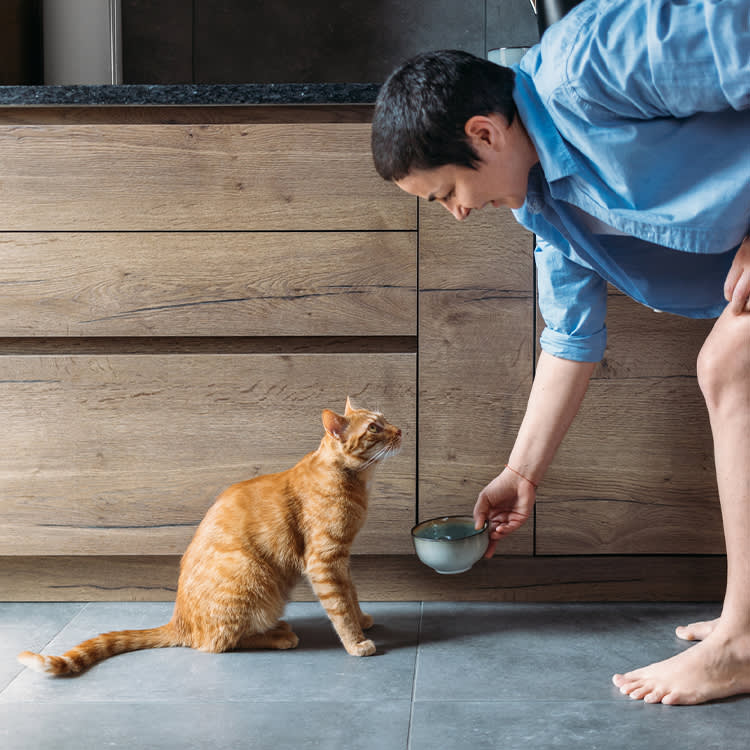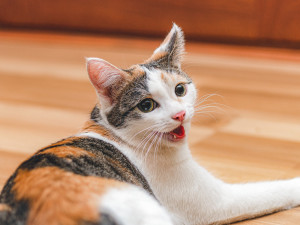How to Get a Cat to Drink Water
Their desert-dwelling roots might resist hydration, but these tricks can help.

Share Article
Ensuring your cat drinks plenty of water is a top health priority. You can try several methods to entice even the most reluctant felines to drink more frequently.
Step One: Provide Running Water Sources.
Offer running water sources, as cats often prefer moving water similar to streams and puddles they would drink from naturally. Fountains with filtration systems keep it clean and appealing. Position their water bowl near their food or lounging areas for easy access.
Step Two: Create Interest.
Try different water vessel shapes, depths, and locations to spark their interest. Give your cat access to sinks or bathtubs with dripping facets. You can also rotate novel bowls and place them on various levels, like countertops or the floor.
Step Three: Flavor Their Water.
Flavor the water lightly with tuna, clam, or chicken broth (no added sodium or onions). Avoid milk, sugary additives, or plant extracts. Extra flavor in your cat’s water appeals to their taste buds, but overly strong flavors may turn them off.

Step Four: Change Up Their Water Sources.
Provide plenty of unique water stations throughout your home, so staying hydrated is easy. Some cats don’t like drinking where their food bowls are, so add options in other rooms, too.
Step Five: Add Fluid with Food.
Consider adding wet food, cat-safe broths, or plain meat baby food to their diet to significantly increase moisture intake if your cat is not drinking enough water directly. These additions make up vital fluid lacking in dry kibble alone.
How can I tell if my cat is drinking enough water?
There are a few ways to tell whether your cat is dehydrated.
Panting: Unlike dogs, cats rarely pant unless there’s something wrong — this could be pain, dehydration, or heat discomfort.
Poor appetite and lethargy.
Eyes sunken into their sockets.
Dry and tacky mucous membranes — which you can most easily check by touching your cat’s gums. Gently press your finger into your cat’s gums; they should turn from white back into their regular pink color in less than two seconds. If your finger sticks, the gums are bright red, or it takes longer than two seconds for them to bounce back, your cat is likely dehydrated.
Skin elasticity: Gently left the skin over your cat’s shoulders, then see how long it takes to fall back into place. In hydrated cats, it should happen almost immediately. In dehydrated cats, the skin can remain “tented” or take a long time to return to its original state. This isn’t a fool-proof test if you have a senior cat, though, because some senior cats have decreased skin elasticity even when they’re hydrated.
What causes dehydration?
Lots of diseases lead to water loss, such as diabetes, kidney disease, some cancer, inflammatory bowel disease, and hyperthyroidism. Dental problems can also cause a cat to avoid their food and water. If your cat seems to be taking in a normal amount of water or getting their fill of wet food but still seems dehydrated, contact your veterinarian to rule out any underlying conditions.
How to get a cat to drink water
If it seems that your cat’s healthy but stubborn (again, you’re not alone), we’ve assembled a list of pro-approved tips on helping your cat feel a little more motivated to lap away.
1. Try running water.
Still water is more likely to grow bacteria, and cats, somewhere deep down in their mysterious evolutionary DNA, know this. Cats prefer to drink moving water because the constant circulation means it’s more likely to be clean — plus, many water fountains include water filters, which your cat might prefer to the tap. They can also see moving things easier than non-moving things, and the sound of moving water can attract them to the source from across the room. “For example, a dripping faucet is enticing to a cat,” Dr. Pendergrass says. “Water fountains also encourage cats to drink more water.”
2. Try a new water bowl location.
Some cats don’t like drinking water that’s too close to their food bowl because they think it might be contaminated; others are just the opposite, and they’re more likely to sip water if they’re reminded to do so during mealtime. If your cat’s not drinking, try experimenting with new water bowl locations and seeing how they react.
Be sure the bowl’s location is away from any stressful noises or movements; for example, lots of cats don’t like to drink near an ice-machine, refrigerator, washing machine, or your clarinet-practicing roommate’s door. Keep the water in a calm, quiet place where your cat can feel secluded from anything startling.
3. Add wet food.
Many vets recommend giving cats wet food instead of, or in addition to, dry kibble. “Wet food has a high moisture content (about 80 percent), which decreases the amount of ‘standalone’ water that a cat needs to drink,” Dr. Pendergrass says. Even if your cat seems water-avoidant, they probably aren’t forgetting to wake you up at five a.m. for their breakfast — so sneaking some moisture into their food can be a great solution.
4. Keep their dish clean.
Cats have super sensitive noses; while humans have five million odor sensors, cats have 200 million. So if you think you can smell when a dish is dirty, your cat definitely can. And for as kind-of-gross (read: hairball-y) cats can seem, they’re remarkably hygienic, and they won’t want to be anywhere near an unclean water source. Along the same lines, make sure to always keep your cat’s water fresh.
5. Fill the water bowl to the top.
As Dr. Deborah Linderopens in new tab of Tufts notes: “Cat’s whiskers are very sensitive to touch and some cats do not like when their whiskers touch the edge of the bowl.” Water filled to the brim of their bowl can help them avoid discomfort.
6. Use different water bowls.
Similarly, cats can often benefit from a raised bowl that allows them to drink without crouching, craning their heads down, and rubbing their whiskers. Plus, raised bowls help aid digestion and slow your cat’s eating. Senior cats will be especially grateful for this assistance.
7. Increase water access.
Cats are kinda like that friend who refuses to order fries but eats half of yours — they can’t be bothered to seek out water, but sure, they’ll have a sip if it’s around. Stick water bowls and fountains in several areas of your apartment to give your cat the low-effort option to sip away in any room they happen to already be chilling in.
8. Add broth.
You ever add one of those lemonade packets to your water bottle to motivate yourself to chug it down? Your cat thinks the same way. Adding a splash of low-sodium chicken broth, tuna juice, or clam juice to your cat’s water can get them excited about sipping.
You can also make the broth into ice cubes, which will both flavor your cat’s water and keep it the cool temperature they prefer. Just be sure that the broth you’re adding isn’t high in salt and wasn’t prepared with onion or garlic, which are toxic to cats. Always check with your veterinarian before switching up your cat’s diet.

Sio Hornbuckle
Sio Hornbuckle is the Assistant Editor at Kinship, where they frequently write for the site. As a writer, they specialize in pet news, animal science, and pop culture. They live in New York City with their cat, Toni Collette.
Related articles
![A cat eating wet food from a dish in the kitchen.]()
8 Cat Meal Toppers for Finicky Eaters
Tips for improving your cat’s appetite with these tasty add-ons.
![Siamese cat coughing]()
Why Is My Cat Coughing?
You thought it was a hairball, but nothing’s coming up…
![Uncomfortable looking gray cat sitting on a window sill]()
Should Your Cat Go to the ER?
Here are six good reasons to haul tail to the emergency room.
![Gray and white striped cat is scratching his ear]()
What’s Up With My Cat’s Skin?
Everything you need to know about cat allergies, according to three veterinary dermatologists.
![]()
How to Read Your Cat’s Poker Face
A guide to their not-so-secret tells.
![kitten lying on the floor breathing through his mouth]()
Is My Cat...Panting?
“Cats don’t pant to cool off like dogs do.” Unless your pet is catching their breath after doing the zoomies, Dr. Gary Weitzman says it could be cause for concern.












